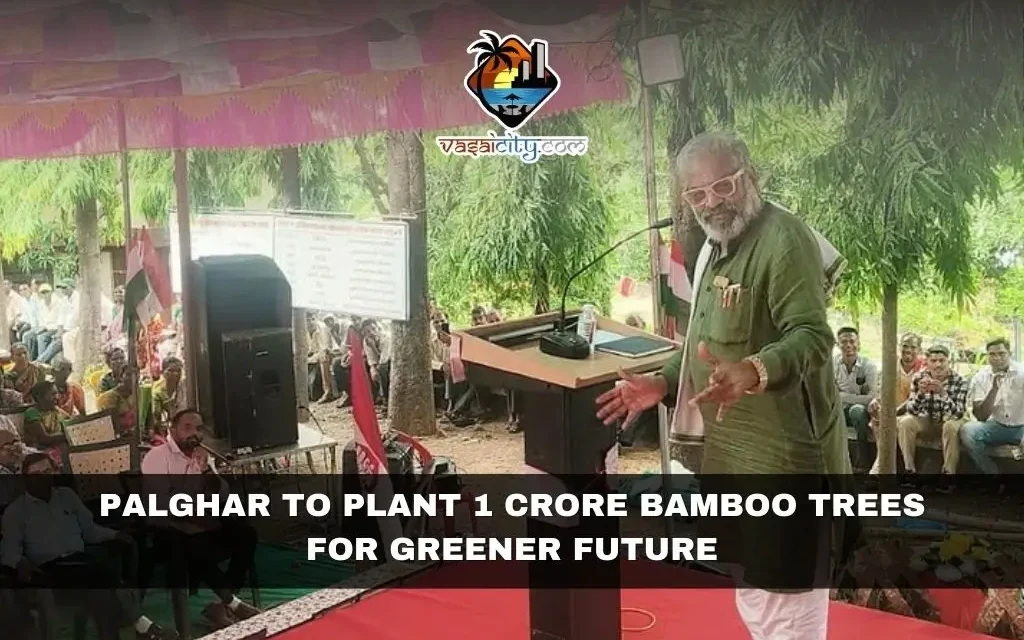In a remarkable step towards both environmental conservation and rural development, the tribal farmers of Palghar district in Maharashtra have come together for a massive bamboo plantation drive. With a target to plant one crore bamboo trees, this mission could not only change the landscape of the region but also become a model for other districts across India.
This large-scale initiative is part of the Bamboo Mission Plantation Programme, which is being spearheaded by the Palghar district administration along with the Shramjeevi Sanghatana, a workers’ organization dedicated to tribal welfare. The aim is simple yet significant—combat climate change, create livelihood opportunities, and ensure a cleaner, greener environment for future generations.
Why Bamboo?
Bamboo isn’t just another plant—it is a fast-growing, sustainable, and eco-friendly alternative to traditional timber. It absorbs carbon dioxide and releases oxygen at a rate much higher than many other trees. As Pasha Patel, Chairman of the State Agricultural Price Commission, rightly pointed out, bamboo is ideal for tackling the visible and worsening effects of climate change.
“Climate change is not a future problem—it’s here and now. We need immediate solutions. Bamboo grows fast and is incredibly useful. This is our answer,” he said during one of the plantation melas.
Bringing the Tribals Onboard
The project has received overwhelming support from local tribal communities. These are the very people who have, after a long legal and administrative struggle, secured rights to forest lease lands (vanpatta). Now, they’re not just cultivating these lands—they’re transforming them.
Farmer melas—essentially village fairs centered around agriculture—have been organized across several talukas including Wada, Vikramgad, Dahanu, Talasari, Mokhada, Jawhar, and Satwali Usgaon. These melas provide farmers with guidance, materials, and encouragement to take up bamboo farming.
Vivek Bhau Pandit, Chairman of the State-Level Tribal Development Review Committee, stressed the importance of this shift:
“Traditional paddy farming is no longer sustainable or profitable for tribal farmers. Bamboo offers a real chance to improve living standards while also helping the environment. With help from the government, we’re targeting 1 crore bamboo trees in Palghar and Thane districts.”
Backing from the Government
This mission isn’t just symbolic—it’s backed by serious policy and funding. Under the Mahatma Gandhi National Rural Employment Guarantee Scheme (MGNREGS), a subsidy of ₹7.04 lakh has been approved to support bamboo plantation activities.
Additionally, the Maharashtra state budget has allocated ₹4,300 crore specifically for bamboo processing this year. That’s not all. As part of the larger effort, the government is supporting product development from bamboo. It’s estimated that over 2,000 different products can be made from bamboo, ranging from furniture and construction materials to eco-friendly handicrafts and even cloth.
MLA Sneha Dubey Pandit also spoke about the long-term vision:
“There is no alternative to bamboo on these lands. It helps the environment and creates jobs. In fact, it can give new life to our villages, while also supporting urban areas like Mumbai with more oxygen.”
Lessons from Other Regions
The idea isn’t without precedent. Sanjeev Karpe, Managing Director of Konbac and an international bamboo expert, shared inspiring stories from Sindhudurg district, where bamboo plantations have already started bearing fruit—both literally and financially. He warned, however, that if the demand continues to rise and supply doesn’t catch up, bamboo could become scarce.
“This is the right time for Palghar. The land is perfect, the people are motivated, and the need is urgent. Let’s not wait,” he said, urging more farmers to participate.
Learning from the Past: The COVID Connection
Many farmers and government officials recall the oxygen crisis during the COVID-19 pandemic, where cities ran out of life-saving oxygen supplies. Bamboo, with its high oxygen output, is now being seen not just as a commercial crop but as a potential lifesaver.
“There’s talk again of COVID cases rising in countries like China, Singapore, and Hong Kong. We know now how vital oxygen is. Trees provide it, and bamboo provides it best,” said Patel.
Hope for a Better Tomorrow
The real strength of this mission lies in its simplicity and scalability. By involving thousands of tribal farmers, many of whom had lost hope due to declining profits from traditional farming, this initiative is providing renewed energy and purpose.
Many farmers are now optimistic. One local tribal farmer shared, “Paddy farming wasn’t helping us anymore. We didn’t earn enough. Bamboo gives us hope—not just for income, but for our children’s future.”
And this hope isn’t just rooted in sentiment—it’s grounded in science and policy. Bamboo not only reduces carbon emissions, but also helps in soil conservation, water retention, and temperature regulation. All this, while also offering income-generating opportunities through product development and potential exports.
The Road Ahead
The real work is just beginning. The next few months will see an accelerated effort in seedling distribution, land preparation, and plantation across thousands of acres in Palghar and Thane. Government departments, local NGOs, and community leaders are joining hands to ensure this mission doesn’t just remain a promise but becomes a long-term transformation.
This initiative may seem focused on a single plant, but its roots run deep—into environmental awareness, community development, and sustainable growth. And if successful, Palghar’s Bamboo Mission could inspire similar green revolutions across India.
With a little support and a lot of determination, one crore bamboo trees might just be the start of something much bigger.









